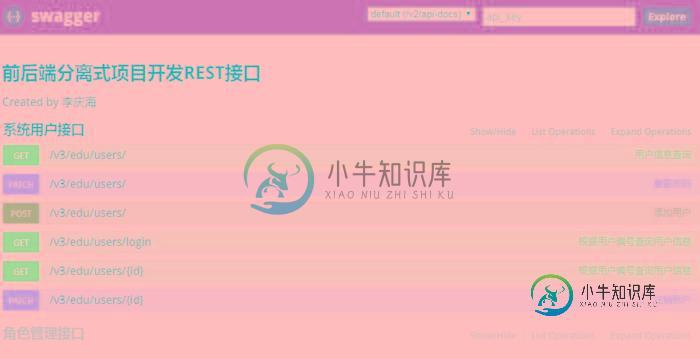浅谈Spring Boot 开发REST接口最佳实践
本文介绍了Spring Boot 开发REST接口最佳实践,分享给大家,具体如下:
HTTP动词与SQL命令对应
GET
从服务器获取资源,可一个或者多个,对应SQL命令中的SELECT GET /users 获取服务器上的所有的用户信息 GET /users/ID 获取指定ID的用户信息
POST
在服务器上创建一个新资源,对应SQL命令中的CREATE POST /users 创建一个新的用户
PUT
在服务器上更新一个资源,客户端提供改变后的完整资源,对应SQL命令中的UPDATE PUT /users/ID 更新指定ID的用户的全部信息
DELETE
从服务器上删除一个资源,对应SQL命令中的DELETE DELETE /users/ID 删除指定ID的用户信息
PATCH
在服务器更新一个资源的部分属性,对应SQL命令中的UPDATE PATCH /users/ID 更新指定ID的用户的某个属性
URL中的约定
URL中名词使用复数形式
URL中的名称是使用单数还是使用复数的问题,争议由来已久。URL中的名词一般对应数据库中的表,表中存储的是同类数据, 在实践中我是强制使用复数形式 ,看上去更舒服些。
/users /users/1 /roles /roles/1
至于一些不规则的、不可数的名词就见仁见智吧。
/heroes /heroes/1 /people /people/1 /foots /foots/1 /feet /feet/1
版本
讲版本号加入到URL中以应对不兼容的和破坏性的更改。发布新API时,客户端可以自如的迁移到新API,不会因调用完全不同的新API而陷入窘境。使用直观的“V”前缀来表示后面的数字是版本号,不需要次级版本号,不应该频繁的发布API版本。
/edu/v1/users /edu/v1/roles
对可选的、复杂的参数使用查询字符串
为了让URL更小、更简洁,为资源设置一个基本URL,讲可选的、复杂的参数用查询字符串表示。
/edu/v1/users?enabled=1&roleid=1
提供分页信息
一次性返回数据库中的所有的资源不是一个好主意,因此需要提供分页机制。通常使用数据库中众所周知的参数offset和limit
/edu/v1/users?enabled=1&offset=1&limit=15
如果客户端没有传递这些参数,则应使用默认值,通常offset=0,limit=10。
非资源请求使用动词
有时API调用并不涉及资源,在这种情况下,服务器执行一个操作病将结果返回给客户端。
/edu/v1/calc?p=100
考虑特定资源和跨资源搜索
提供对特定止缘的搜索很容易,只需要使用相应的资源集合,并将搜索字符串附加到查询参数中即可。
/edu/v1/users?username=李庆海
如果需要对所有资源提供全局搜索,则需要使用其他方法。
/edu/v1/search?key=李庆海
响应结果
使用小驼峰命名法作为属性标识符
通常,RESTful Web服务将被JavaScript编写的客户端使用。客户端会将JSON响应转换为JavaScript对象,然后调用其属性。因此,最好遵循JavaScript代码通用规范。
person.year_of_birth // 不推荐,违反JavaScript代码通用规范 person.YearOfBirth // 不推荐,JavaScript构造方法命名 person.yearOfBirth // 推荐
提供分页信息
返回结果比较多时,应提供分页信息。
{
"page": 0,
"size": 10,
"total": 3465,
"obj": [
]
}
Spring MVC开发REST接口
常用注解
@RestController
@RestController是@ResponseBody和@Controller的组合注解。
@RequestMapping
此注解即可以作用在控制器的某个方法上,也可以作用在此控制器类上。当控制器在类级别上添加@RequestMapping注解时,这个注解会应用到控制器的所有处理器方法上。处理器方法上的@RequestMapping注解会对类级别上的@RequestMapping的声明进行补充。
@PostMapping
组合注解,是@RequestMapping(method =RequestMethod.POST)的缩写。
@PutMapping
组合注解,是@RequestMapping(method = RequestMethod.PUT)的缩写。
@PatchMapping
组合注解,是@RequestMapping(method = RequestMethod.PATCH)的缩写。
@DeleteMapping
组合注解,是@RequestMapping(method = RequestMethod.DELETE)的缩写。
@GetMapping
组合注解,是@RequestMapping(method = RequestMethod.GET)的缩写。
@PathVariable
获取url中的数据。
@RequestParam
获取请求参数的值。
REST接口及Swagger 编写API文档示例
关于Swagger的使用可参考Spring Boot 项目中使用Swagger2 。方法体中的代码不重要,重要的是方法的签名以及与HTTP动词的映射。
import java.util.Date;
import javax.persistence.EntityNotFoundException;
import org.springframework.beans.factory.annotation.Autowired;
import org.springframework.data.domain.Page;
import org.springframework.web.bind.annotation.GetMapping;
import org.springframework.web.bind.annotation.PatchMapping;
import org.springframework.web.bind.annotation.PathVariable;
import org.springframework.web.bind.annotation.PostMapping;
import org.springframework.web.bind.annotation.RequestBody;
import org.springframework.web.bind.annotation.RequestMapping;
import org.springframework.web.bind.annotation.RequestParam;
import org.springframework.web.bind.annotation.RestController;
import cn.com.infcn.jianshu.Service.UserService;
import cn.com.infcn.jianshu.exception.BizException;
import cn.com.infcn.jianshu.exception.LoginNameOrPasswordErrorException;
import cn.com.infcn.jianshu.exception.ResourceExistsException;
import cn.com.infcn.jianshu.model.User;
import cn.com.infcn.jianshu.util.JsonResult;
import io.swagger.annotations.Api;
import io.swagger.annotations.ApiOperation;
import io.swagger.annotations.ApiParam;
/**
* 系统用户Controller
*
* @author 李庆海
*
*/
@Api(value = "系统用户接口", tags = "系统管理")
@RestController
@RequestMapping("/v3/edu/users")
public class UserController {
@Autowired
private UserService userService;
/**
* 添加用户,注册
*
* @param loginName
* 登录账号
* @param userName
* 用户名称
* @param password
* 登录密码
* @param roleId
* 用户角色
* @return
* @throws ResourceExistsException
*/
@ApiOperation(value = "添加用户")
@PostMapping("/")
public JsonResult create(
@ApiParam(name = "loginName", value = "登录账号", required = true) @RequestParam(required = true) @RequestBody String loginName,
@ApiParam(name = "userName", value = "用户名称", required = true) @RequestParam(required = true) @RequestBody String userName,
@ApiParam(name = "password", value = "登录密码", required = true) @RequestParam(required = true) @RequestBody String password,
@ApiParam(name = "roleId", value = "用户角色编号", required = true) @RequestParam(required = true) @RequestBody String roleId)
throws ResourceExistsException {
boolean exists = this.userService.exists(loginName);
if (exists) {
throw new ResourceExistsException(loginName);
}
User user = userService.create(loginName, password, userName, roleId);
return JsonResult.success(user);
}
/**
* 用户凭借登录账号和登录密码进行登录
*
* @param loginName
* 登录账号
* @param password
* 登录密码
* @throws EntityNotFoundException
*/
@ApiOperation(value = "根据用户编号查询用户信息")
@GetMapping("/login")
public JsonResult login(
@ApiParam(name = "loginName", value = "登录账号", required = true) @RequestParam(required = true) String loginName,
@ApiParam(name = "password", value = "登录密码", required = true) @RequestParam(required = true) String password)
throws LoginNameOrPasswordErrorException {
User user = this.userService.login(loginName, password);
if (null == user) {
throw new LoginNameOrPasswordErrorException();
}
return JsonResult.success(user);
}
/**
* 根据用户编号查询用户信息
*
* @param id
* 用户编号
* @throws EntityNotFoundException
*/
@ApiOperation(value = "根据用户编号查询用户信息")
@GetMapping("/{id}")
public JsonResult read(
@ApiParam(name = "id", value = "用户编号,主键", required = true) @PathVariable(required = true) String id)
throws EntityNotFoundException {
User user = this.userService.getOne(id);
return JsonResult.success(user);
}
/**
* 账户注销,不删除用户的数据
*
* @param userId
* 用户编号
* @return
*/
@ApiOperation(value = "注销账户")
@PatchMapping("/{id}")
public JsonResult cancel(
@ApiParam(name = "id", value = "用户编号,主键", required = true) @PathVariable(required = true) String id)
throws EntityNotFoundException {
this.userService.cancel(id);
return JsonResult.success();
}
/**
* 重置密码
*
* @param id
* 用户编号
* @param password
* 新登录密码
* @return
*/
@ApiOperation(value = "重置密码")
@PatchMapping("/")
public JsonResult updatePassword(
@ApiParam(name = "id", value = "用户编号,主键", required = true) @RequestParam(required = true) String id,
@ApiParam(name = "password", value = "新登录密码", required = true) @RequestParam(required = true) String password) {
this.userService.updatePassword(id, password);
return JsonResult.success();
}
/**
* 多条件组合查询
*
* @param userName
* 用户名称
* @param roleId
* 用户角色
* @param start
* 开始日期
* @param end
* 结束日期
* @param page
* 分页,从0开始
* @param size
* 每页的行数,默认10
* @return
* @throws BizException
*/
@ApiOperation(value = "用户信息查询")
@GetMapping("/")
public JsonResult query(
@ApiParam(name = "userName", value = "用户名称,查询关键词", required = false) @RequestParam(required = false) String userName,
@ApiParam(name = "roleId", value = "用户角色编号", required = false) @RequestParam(required = false) String roleId,
@ApiParam(name = "start", value = "用户角色编号", required = false) @RequestParam(required = false) Date start,
@ApiParam(name = "end", value = "用户角色编号", required = false) @RequestParam(required = false) Date end,
@ApiParam(name = "page", value = "分页,第几页,从1开始", defaultValue = "1", required = true) @RequestParam(defaultValue = "1", required = true) int page,
@ApiParam(name = "size", value = "每页的行数,正整数", defaultValue = "10", required = true) @RequestParam(defaultValue = "10", required = true) int size)
throws BizException {
Page<User> datas = this.userService.findDatas(userName, roleId, start, end, page, size);
if (null == datas || null == datas.getContent() || datas.getContent().isEmpty()) {
throw new BizException("用户不存在");
}
return JsonResult.success(datas);
}
}
Swagger2接口文档效果图

以上就是本文的全部内容,希望对大家的学习有所帮助,也希望大家多多支持小牛知识库。
-
本文向大家介绍浅谈使用 PHP 进行手机 APP 开发(API 接口开发),包括了浅谈使用 PHP 进行手机 APP 开发(API 接口开发)的使用技巧和注意事项,需要的朋友参考一下 一、先简单回答两个问题: 1、PHP 可以开发客户端? 答:可以,因为PHP是脚本语言,是负责完成 B/S架构 或 C/S架构 的S部分,即:主要用于服务端的开发。但是,PHP可不仅仅只能在互联网站上发展,一个PHP
-
本文向大家介绍浅谈AJAX开发技术,包括了浅谈AJAX开发技术的使用技巧和注意事项,需要的朋友参考一下 AJAX(Asynchronous JavaScript and XML,异步JavaScript和XML),AJAX并不是一项新的技术,它产生的主要目的是用于页面的局部刷新,从之前的代码开发来看,读者可以发现,每当用户向服务器端发出请求时,那怕需要的只是简单的更新一点点的局部内容,服务器端都会
-
服务开发最佳实践 一、服务 二、版本 三、API 1、非托管API 2、托管API 服务开发最佳实践 更新时间:2018-03-20 21:45:44 服务开发的流程从创建服务开始,每一个服务下可以创建多个版本,每一个版本下可以创建多个API。 一、服务 我们建议为每个服务取一个有意义的名字,同时为该服务打上标签。每一个服务最终将是一组API的集合,这些API具有某些共性,存在于一个服务之下。比如
-
Egg.js 的官方文档已经很完善了,想学习 Egg.js 的可以直接查看官方文档,但是如果只是开发接口,这个教程将你是最好的选择。
-
本文向大家介绍浅谈Xcode 开发工具 XCActionBar,包括了浅谈Xcode 开发工具 XCActionBar的使用技巧和注意事项,需要的朋友参考一下 XCActionBar 是一个用于 Xcoded 的通用生产工具。 下载地址:https://github.com/pdcgomes/XCActionBar 基本命令: (1)「command+shift+8」或者双击「command」键可
-
本文向大家介绍浅谈SpringBoot是如何实现日志的,包括了浅谈SpringBoot是如何实现日志的的使用技巧和注意事项,需要的朋友参考一下 前言 休息日闲着无聊看了下 SpringBoot 中的日志实现,把我的理解跟大家说下。 门面模式 说到日志框架不得不说门面模式。门面模式,其核心为外部与一个子系统的通信必须通过一个统一的外观对象进行,使得子系统更易于使用。用一张图来表示门面模式的结构为:

